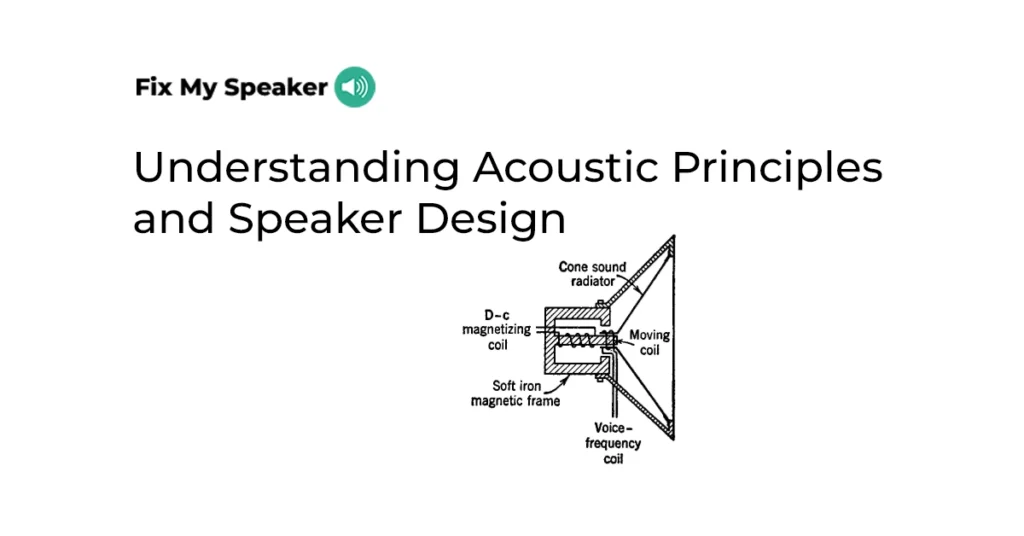Acoustic principles and speaker design are fundamental to high-quality sound reproduction. This article explores key concepts in speaker technology, focusing on how sound is produced and how speakers are engineered to deliver optimal audio performance across various environments and applications.
If your phone's speaker has been exposed to water & dust, you can use our Fix My Speaker tool to help extract moisture and restore sound quality.
What Are the Acoustic Principles of Speakers?
Definition of Acoustic Principles
Acoustic principles are the scientific laws governing sound generation, transmission, and reception. These principles form the foundation of speaker design, determining how audio signals are converted into audible sound waves. They encompass concepts such as wave propagation, resonance, and impedance, which are crucial for creating speakers that accurately reproduce sound.
How Sound Waves Work in Speakers
Speakers generate sound waves through the vibration of a diaphragm, typically a cone or dome. This process involves:
- Electromagnetic conversion: The speaker’s voice coil, which is attached to the diaphragm, sits within a magnetic field created by a permanent magnet.
- Diaphragm movement: When an electrical audio signal passes through the voice coil, it creates a fluctuating magnetic field that interacts with the permanent magnet, causing the coil and attached diaphragm to move back and forth.
- Air pressure changes: As the diaphragm moves, it pushes and pulls the air in front of it, creating alternating areas of high and low air pressure.
- Sound wave propagation: These pressure variations travel through the air as sound waves, which our ears interpret as sound.
This process allows speakers to transform electrical signals into the rich, complex sounds we hear in music, speech, and other audio content.
What Is Speaker Frequency Response?
Definition and Importance
Speaker frequency response is the range of frequencies a speaker can reproduce accurately at a consistent volume level. It is typically measured in Hertz (Hz) and is crucial for determining a speaker’s ability to faithfully reproduce audio signals. A wide, flat frequency response is generally desirable, as it indicates the speaker can reproduce both low bass notes and high treble sounds with equal clarity.
Frequency Response Curves
Frequency response curves graphically represent a speaker’s output across the audible spectrum. These curves show:
- Frequency range: This is usually expressed as a range, such as 20 Hz – 20 kHz, representing the lowest and highest frequencies the speaker can reproduce.
- Amplitude variations: The curve shows how the speaker’s output level changes across different frequencies, ideally remaining relatively flat.
- Peaks and dips in response: Any significant deviations from a flat response are visible as peaks (emphasized frequencies) or dips (attenuated frequencies) in the curve.
Audio engineers use these curves to assess and refine speaker performance, identifying areas where the speaker may be over- or under-emphasizing certain frequencies.
Impact on Sound Quality
Frequency response significantly affects sound quality by influencing:
- Tonal balance: A speaker with a flat frequency response will reproduce sounds across all frequencies equally, maintaining the intended balance of an audio recording.
- Clarity of different instruments: Accurate frequency response ensures that each instrument in a mix is reproduced faithfully, without some being artificially emphasized or diminished.
- Overall accuracy of reproduction: A speaker with good frequency response will produce sound that closely matches the original audio signal, providing a more authentic listening experience.
A flat frequency response is often considered ideal, as it indicates the speaker reproduces all frequencies equally, without emphasizing or diminishing specific ranges. However, some listeners may prefer slight deviations from flat for a more pleasing subjective experience.
What Is Impedance in Speakers?
Definition of Impedance
Impedance in speakers is the total opposition a speaker presents to the flow of alternating current from an amplifier. Measured in ohms (Ω), impedance is a critical factor in speaker design. It combines the speaker’s electrical resistance and reactance, which varies with frequency. Most home audio speakers have a nominal impedance of 4Ω, 6Ω, or 8Ω.
Impedance Matching
Impedance matching is the process of ensuring compatibility between a speaker’s impedance and an amplifier’s output impedance. Proper matching is crucial for:
- Optimal power transfer: Matched impedances allow maximum power transfer from amplifier to speaker.
- Preventing damage: Mismatched impedances can overload amplifiers or speakers.
- Maintaining sound quality: Correct matching ensures accurate frequency response and reduces distortion.
Amplifiers are typically designed to work with a specific range of speaker impedances. Using speakers with the correct impedance ensures the amplifier operates within its safe and optimal performance range.
How Impedance Affects Performance
Impedance influences speaker performance in several ways:
- Efficiency: Lower impedance speakers generally produce more volume for a given input power, but require more current from the amplifier.
- Frequency response: Impedance variations across frequencies can affect the speaker’s tonal balance.
- Amplifier compatibility: Different impedances may require specific amplifier designs for optimal performance.
- Power handling: Impedance affects the speaker’s ability to handle power from the amplifier without distortion or damage.
Understanding impedance is crucial for both speaker designers and audio enthusiasts to achieve optimal system performance and prevent potential issues.
How Does Speaker Enclosure Design Affect Sound?
Types of Speaker Enclosures
Speaker enclosures come in various designs, each with unique acoustic properties:
- Sealed (Acoustic Suspension): A completely enclosed box that provides tight, accurate bass response.
- Ported (Bass Reflex): Features a tuned port or vent to enhance low-frequency output.
- Bandpass: Uses a combination of sealed and ported chambers for emphasized bass response.
- Transmission Line: Employs a long, folded tunnel to control bass frequencies.
- Horn-Loaded: Uses a flared opening to increase efficiency and control dispersion.
Each type offers different advantages in terms of bass response, efficiency, and overall sound character.
Comparison of Speaker Enclosure Types
| Enclosure Type | Bass Response | Efficiency | Size | Typical Use Cases |
| Sealed (Acoustic Suspension) | Tight, accurate | Moderate | Compact | Studio monitors, high-fidelity systems |
| Ported (Bass Reflex) | Extended, higher output | Higher | Larger | Home theater, general-purpose speakers |
| Bandpass | Emphasized, narrow range | High | Large | Car audio, subwoofers |
| Transmission Line | Deep, well-controlled | Moderate | Very Large | High-end audio systems |
| Horn-Loaded | Efficient, directional | Very high | Large | Professional sound, outdoor venues |
Acoustic Impact of Enclosure Design
Enclosure design significantly affects sound reproduction:
- Bass response: Ported designs can extend low-frequency output but may sacrifice some accuracy compared to sealed enclosures.
- Efficiency: Certain designs, like horn-loaded enclosures, can greatly increase a speaker’s efficiency.
- Sound staging: The enclosure shape and size influence how sound waves disperse, affecting the perceived soundstage.
- Resonance control: Well-designed enclosures minimize unwanted resonances that can color the sound.
The choice of enclosure design depends on the intended use, room acoustics, and desired sound characteristics.
Materials and Construction
The materials used in speaker enclosures play a crucial role in sound quality:
- Medium-Density Fiberboard (MDF): Commonly used for its density and inert properties.
- Plywood: Offers a good balance of strength and resonance control.
- Aluminum: Provides excellent rigidity and heat dissipation.
- Composites: Advanced materials like carbon fiber offer high strength-to-weight ratios.
Construction techniques such as internal bracing, damping materials, and precise joinery further influence the enclosure’s acoustic properties. The goal is to create a structure that minimizes vibrations and colorations, allowing the speaker drivers to perform optimally.
What Are Speaker Crossover Networks?
Definition and Function
Speaker crossover networks are electronic circuits that divide the audio signal into different frequency ranges, directing each range to the appropriate driver. Their primary functions include:
- Frequency separation: Splitting the audio spectrum for specialized drivers (e.g., woofers, midrange, tweeters).
- Driver protection: Preventing damage by sending only appropriate frequencies to each driver.
- Optimizing performance: Ensuring each driver operates within its optimal frequency range.
Crossovers are crucial for multi-driver speakers, allowing each component to reproduce the frequencies it handles best.
Types of Crossover Networks
There are two main types of crossover networks:
- Passive Crossovers:
- Consist of capacitors, inductors, and resistors
- Installed inside the speaker enclosure
- Do not require external power
- Generally simpler and more cost-effective
- Active Crossovers:
- Use electronic components to split the signal
- Placed before the power amplifier in the signal chain
- Require separate amplification for each frequency band
- Offer greater flexibility and precision in frequency division
Each type has its advantages, with active crossovers providing more control but requiring more complex setups.
| Feature | Passive Crossovers | Active Crossovers |
| Power Requirement | No external power needed | Requires power supply |
| Placement | Inside speaker enclosure | Before power amplifier |
| Flexibility | Limited adjustability | Highly adjustable |
| Cost | Generally lower | Higher (requires multiple amps) |
| Signal Path | After amplification | Before amplification |
| Efficiency | Can reduce overall efficiency | More efficient power use |
| Complexity | Simpler design | More complex system |
| Driver Control | Limited | Precise control over each driver |
Design Considerations
Key considerations in crossover design include:
- Crossover frequency: Choosing the optimal point to transition between drivers
- Slope: Determining how quickly the signal attenuates outside the passband
- Driver characteristics: Matching the crossover to the specific drivers’ frequency response
- Phase alignment: Ensuring drivers work in unison at the crossover point
- Component quality: Using high-grade components to minimize distortion
Proper crossover design is essential for achieving seamless integration between drivers and optimal overall speaker performance.
Take Aways
This article has explored fundamental aspects of acoustic principles and speaker design:
- Acoustic principles governing sound generation in speakers
- The importance of frequency response in sound reproduction
- The role of impedance in speaker-amplifier interaction
- How enclosure design affects sound quality
- The function and types of crossover networks


